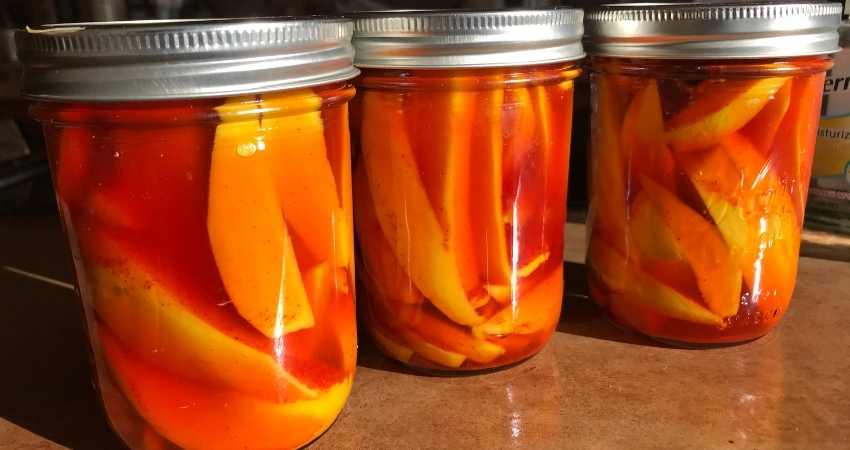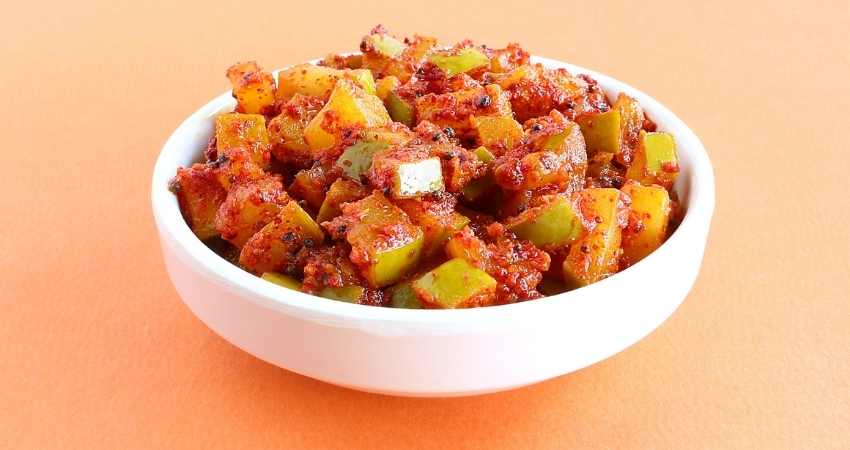These Are The Best Mango Types For Pickling And More
With over 500 different types of mangoes, which mango is best for pickling?
The best mangoes for pickling are sour, firm and fleshy. In addition, unripe, green mangoes are good for pickling. The following varieties are the best mangoes for pickling:
- Ramkela
- Alphonso
- Rajapuri
- Haden
- Kent
- Brooks
Any raw mango will do for pickling but they’ll taste and perform differently when pickled. Therefore, some are better than others. I’ll explain the best ones to you in this article.

The Best Mangoes For Pickling
1. Ramkela Mango
The Ramkela has a sour taste and firm flesh which makes it good for pickling. It’s mainly grown for pickling purposes only. It’s flavor and aroma are unique but it’s a difficult mango to find depending on your location in the world.
2. Alphonso or Hapus Mango
Also known as the king of the mangoes, the Alphonso is large, sweet-tasting and pleasant smelling. Many people use this mango to make sweet pickled mangoes. They have very soft, non-fibrous flesh.
Therefore, it’s best to use them for pickling before they ripen. This will give the pickled mango a more sour taste, which is desirable for mango pickles1.
3. Rajapuri Mango
This mango will be difficult to find but if you do you’ll have a good mango for pickling. They’re known for their large size but have a small seed. Rajapuri has a sweet flavor and is used to make various products. When it’s unripe, it has a sour taste and hard pulp.
4. Haden Mango
The Haden mango goes through a few stages of flavor. When it’s unripe, it’s firm and can taste bitter and sour. At this green stage of development, the Haden mango will produce a more tart, strongly flavored mango pickle.
However, when this mango ripens, it becomes very sweet and the fruit becomes very soft. This makes it only suitable for a short-term pickling process. At this ripe stage, the pickle will be very soft, sweet and likely to fall apart2.
5. Kent Mango
The Kent mango has a very rich, sweet flavor. It’s not the biggest mango, but the flesh has an ideal consistency for pickling. This is because it’s smooth and dense with just a small amount of fibrous flesh to keep it solid and stable. This mango will produce a more sweet pickle3.
6. Brooks Mango
This mango is best used for pickling when it’s green and unripe. The Brooks mango has a medium fibrous flesh that’s quite firm when it is unripe. This allows it to hold together well in the pickling process.
The Brooks takes on the flavors of the pickling ingredients well because of its type of flesh. If it’s used for pickling when it is ripe, it will be sweet and soft4.

Other Mangoes Ideal For Pickling
Any raw mango can be used for mango pickles. There are varieties only available in specific countries. Each country has its own unique recipes and variations of mango pickles.
There are a few varieties of mango that are commonly available for purchase almost everywhere. On the other hand some aren’t easily found but good for pickling like the following:
- The Avakaya Mango
- The Dasheri Mango
- The Chaunsa Mango
- The Desi Mango
What Makes The Best Mango Varieties For Pickle
The best mangoes to use for picking are sour, firm, large and slightly fibrous. The sourness of pickling mangoes will produce a fantastic flavor. The flavor of the mango will remain in the pickling spices.
Firm mangoes will better withstand the softening that happens when a mango is pickled. This enables the mango to remain firm and easily accessible and useable. The firmer the mango, the longer it can be pickled before turning into mush.
Large mangoes are ideal for pickling because they can be used to make multiple batches with varying flavors and amounts of time. The larger the mango, the more food you can harvest from it.
A medium to slightly fibrous flesh in the mango is ideal for pickling. This means the flesh of the fruit is more porous. This allows it to soak in the flavors of the spices, herbs, and oils used for pickling the mango.
Why Some Mangoes are Better For Pickling
The outcome of pickling a mango entirely depends on the variety of mango used. Some mangoes are better eaten ripe and raw while some are best when they are cooked. A few reach their peak when they’re dried but are best used for pickling.
These mangoes are uncommon to find. It depends on where you are in the world. Many tropical countries like India and The Philippines have unique varieties of mango only found in those countries and are grown specifically for pickling.
The best mangoes to use for pickling are ones that retain their consistency during the pickling process and retain their flavor. In addition, they take on the flavors of herbs and spices well.
If the mango is going to fall apart when it is pickled, it may be better suited for a chutney rather than a pickle.
If a mango has a very strong flavor and does not absorb the flavors of the pickling spices well, it may be better to cook and enjoy it on its own.
For these reasons, some mangoes are better for pickling than others are. Some mangoes are best used for pickling when they are green and unripe because their flesh is more firm and sour than when they ripen.
Mango Pickles: What They Are
Many varieties of mangoes grow very well all over the world in tropical climates. In the countries where mangoes were originally found, like India, Bangladesh, and The Philippines, the native people developed ways of preserving mangoes to be eaten throughout the year.
One of the most popular and tried and tested preservation techniques for mangoes is pickling. This is the process of preserving the mangoes in oil with aromatic spices and herbs.
Mango pickles have become a staple part of the diet of many people all over the world. No longer is it a way to keep mangoes edible for long periods of time. It has become a delectable dish on its own. Many pickle makers have refined their own unique and preferred recipes for years5.
Pickled mangoes can range from sour and firm to soft and sweet. In addition, some are savory and very spicy. It all depends on the recipe used and most importantly, the type of mango that’s being pickled.
Although more popular in India, lucky for us, they are available on Amazon for purchasing. If this article is making you crave some mango pickle, take a look at the varieties listed by clicking here, mango pickle.
Why the Tommy Atkins Mango is Not Good For Pickling
The Tommy Atkins mango is not the best for pickling because it has a mild flavor and fibrous flesh. Since it’s large and keeps well, it’s the most commonly found mango in the world. Therefore, it’s often used for mango pickles anyway.
Using spices and herbs to increase the flavor when pickled may be necessary when pickling this mango6.
If you have any questions to ask me about this article don’t hesitate to comment below or email us. You can find an email on our contact page.
Read Next – More Food Alternatives
The Best Balsamic Vinegar Substitute
5 Best Alternatives for Spinach When Cooking
10 Best Alternatives for Avocado in Sushi
5 Best Alternatives for Pomegranate in Salad
- The Economic Times: King of mangoes “Alphonso” gets GI tag [↩]
- Mango.org: Pickling Mangos [↩]
- Mango.org: Mango Varieties & Availability [↩]
- Berkely Wellness: Types of Mangos [↩]
- Wikipedia: Mango pickle [↩]
- Wikipedia: Tommy Atkins (mango) [↩]
